|
The
Geometric properties of mutually tangent circles have been studied for centuries
by Geometers such as Apollonius of Perga in Greece (3rd Century
B.C.), Rene Descartes of France (circa 1643), Phillip Beecroft of England
(1842), and Frederick Soddy in 1936 to name but a few[i].
Also called “Kissing Circles”, this geometric construction usually involves
two or more circles which touch one another at only one point, the point of
tangency. Figure 1 illustrates three mutually tangent circles. When three
circles are arranged such that they are mutually tangent the resulting figure is
called a Tangent Triad. Connecting the centers of a tangent triad forms a
triangle (Triangle ABC in Figure 1).
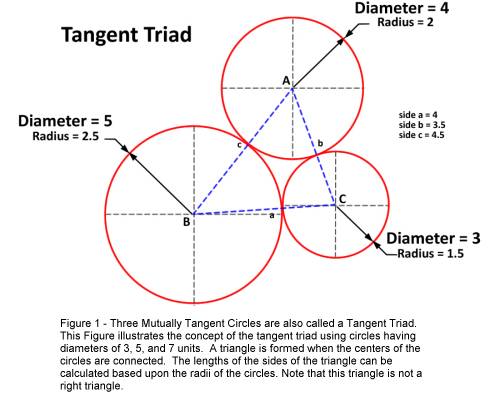
Soddy,
who received the Nobel Prize for Chemistry in 1921 was so taken with “kissing
circles” that he penned a poem[ii]
about them, which reads in part:
“For
pairs of lips to kiss maybe
Involves
no trigonometry.
'Tis not so when four circles kiss
Each one the other three.
To bring this off the four must be
As three in one or one in three.
If one in three, beyond a doubt
Each gets three kisses from without.
If three in one, then is that one
Thrice kissed internally.”
Figure
1 illustrates three mutually tangent circles having diameters of 3, 4, and 5
units, which have been constructed with their centers at the vertices of a
triangle. Notice in this figure that the lengths of the sides of the triangle
are the sum of the radii of the two circles which lie at the endpoints of the
sides (the triangle vertices). Therefore we find side “b” to have a length
equal to 3.5 units, side “a” has a length equal to 4 units, and side “c”
a length equal to 4.5 units.
While
pondering “Kissing Circles” one day (with regrettably less passion than Mr.
Soddy) I began to wonder what I might find if I constructed three mutually
tangent circles with their centers at the vertices of a Pythagorean Right
Triangle having sides with lengths of 3, 4, and 5 units. I have often speculated
that the Figure of Proof for the Pythagorean Theorem developed by Euclid is
important to Freemasons not because of its intrinsic mathematical value but
because it specifically makes use of a 3, 4, 5 right triangle. Historically, the
3, 4, 5 right triangle is believed to make allusion to the Trinity of Osiris,
Isis, and Horus or to the principle of the divine masculine, divine feminine,
and the union of the two.
What
I discovered during this construction is quite interesting; whether or not it
was actually Pythagoras who truly exclaimed “Eureka” upon discovery of the
unique philosophical, mystic, and geometrical properties of the 3, 4, 5 right
triangle, I believe that he was definitely onto something.
Construction
of the Figure
In my construction of the figure, I decided that the simplest approach
was to work out the required dimensions and positions of the circles first, and
to then overlay my 3, 4, 5 triangle upon the result. With a bit of math and
reasoning, I determined that the diameters of my circles needed to be 2, 4, and
6 units and that each of the two larger circles needed to be positioned at right
angles to the third, smaller circle. Naturally, the three circles would also
need to be tangent to one another. Figure 2 below illustrates the result of my
construction.
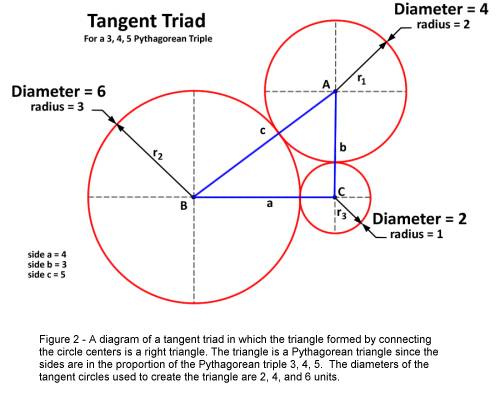
I have connected the centers of each circle in Figure 2 to form a right
triangle. Note that by adding the length of the radii of the two circles which
comprise them, the lengths of the sides of the triangle may be determined.
Mathematically speaking:
a
= r1 + r2 = 1 + 3 = 4
b
= r1 + r3 = 1 + 2 = 3
c
= r2 + r3 = 3 + 2 = 5
Notice also that the centers of Circle “C” and Circle “A” and
(separately) of Circle “C” and Circle “B” are collinear and that the two
pairs of circles are aligned ninety degrees to one another. Triangle “ABC”
therefore is a 3, 4, 5 right triangle.
I will note at the outset that one of the interesting characteristics of
this construction lies in the fact that the perimeter of the triangle (3 + 4 + 5
= 12) and the sum of the diameters of the three circles used in my tangent triad
(2 + 4 + 6 = 12) are identical.
With tangent triads (or any circles which are mutually tangent), lines
(tangent lines) drawn through the points of tangency will all intersect at a
point which is the center of the triangle. Figure 3 illustrates this. In Figure
3, Point “D” represents the intersection of tangent lines at the center of
the triangle. The same point (Point “D”) may also be located by the
intersection of three lines bisecting each of the angles of Triangle “ABC”.
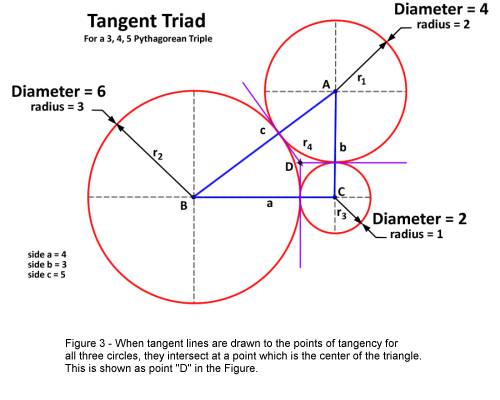
An additional feature which I discovered concerning this center point is
that a circle (called an in-circle[iii])
inscribed in the 3, 4, 5 triangle, such that it is exactly tangent to all three
sides of the triangle, will be exactly two units in diameter (the same as circle
“C”). This is illustrated by
Figure 4, and can be confirmed by calculation of the in-circle radius using a
standard formula[iv] as follows:
r4
= [(a) (b)] / (a + b + c)
r4
= [(3) (4)] / (3 + 4 + 5)
r4
= 12 / 12 = 1
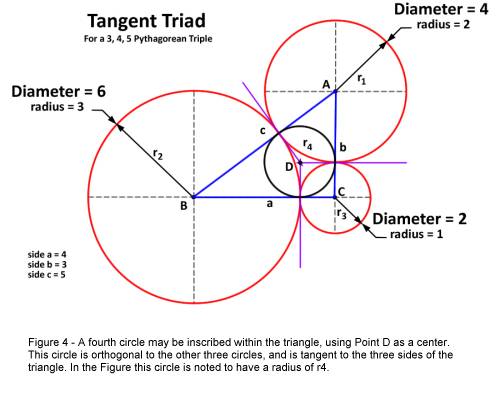
Therefore,
with a radius of 1 unit, the diameter of Circle “D” is 2. In our Figure
then, Circle “C” and Circle “D” are the same in diameter.
For clarity, in Figure 5 I have constructed lines which are tangent to
Circle “D” and to Circle “C”. The obvious result is that the Masonic
Symbol (shown in black ink) of the “Point Within A Circle” appears.
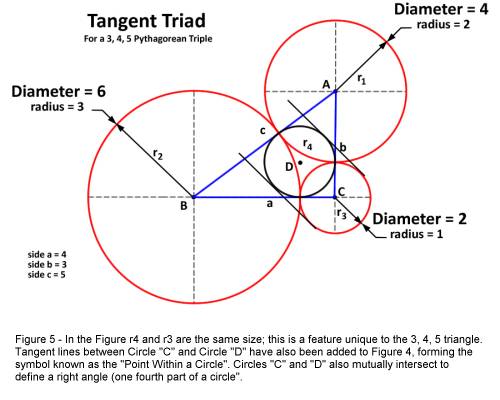
The
only triangle which has an in-circle with a radius of 1 (a diameter of 2) is the
3, 4, 5 right triangle. When considering the relative positions of Circle
“C” and Circle “D” in Figure 4, note that the two circles overlap such
that they intersect one another at their circumferences to exactly define a
right angle (one-fourth part of a circle).
I
will leave it to the reader to marvel at the fact that at least three important
Geometric constructions, which are closely identified with Freemasonry, may be
derived from this single construction. From the standpoint of Pythagoras, I
believe that geometric characteristics such as these would have further affirmed
his belief in the divine nature of the 3, 4, 5 triangle.
[i]
Ballew, Pat. “Soddy’s Formula”. Math Words, and Some Other Words
of Interest. Retrieved December 1, 2008 from http://www.pballew.net/soddy.
[ii]
Soddy, Frederick. (1937). “The Kiss Precise”. Nature, Volume 139, Issue
3506, pp. 62.
[iii]
Bernhart, Frank; Price, H. Lee. ( 2007). Heron's Formula, Descartes
Circles, and Pythagorean Triangles. Cornell University Library. arXiv:math/0701624.
Retrieved December 1, 2008 from http://arxiv.org/PS_cache/math/pdf/0701/0701624v1.pdf.
[iv]
Knott, Ron. (2008). “Three Formulae for the Inradius”. University of
Surrey. Department of Engineering and Physical Sciences. Retrieved December 1,
2008 from http://www.mcs.surrey.ac.uk/Personal/R.Knott/Pythag/pythag.html#incircle.
|
![]() News Feed |
News Feed |  Subscribe News by Email
Subscribe News by Email